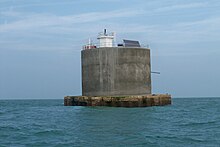 | |
 | |
| Location | Nab Rocks, near the Isle of Wight, England |
|---|---|
| Coordinates | 50°40′03″N 0°57′04″W / 50.66749733°N 0.951162862°W[1] |
| Tower | |
| Constructed | 1918 towed into position 1920 |
| Construction | Steel and concrete |
| Automated | 1983 |
| Height | 17 m (56 ft)[2] |
| Shape | Broad cylindrical tower faced with reinforced concrete |
| Markings | Unpainted tower, white light |
| Operator | Trinity House[3] |
| Fog signal | 1 blast every 30s. (range 2 nmi (3.7 km)) |
| Racon | T |
| Light | |
| First lit | 1920 |
| Focal height | 17 m (56 ft) |
| Light source | Vega LED lantern |
| Intensity | 2,850 candela[2] |
| Range | 12 nmi (22 km) |
| Characteristic | Fl W 10s. |
The Nab Tower is a tower originally planned for anti-submarine protection in the English Channel in World War I. It was sunk over the Nab rocks east of the Isle of Wight to replace a lightship after the war, and is a well-known landmark for sailors as it marks the deep-water eastern entry into the Solent.
- ^ Latitude
- ^ a b Nab Tower Lighthouse. Retrieved 3 May 2016
- ^ Rowlett, Russ. "Lighthouses of Southern England". The Lighthouse Directory. University of North Carolina at Chapel Hill. Retrieved 3 May 2016.